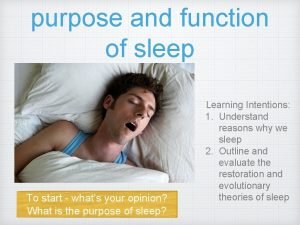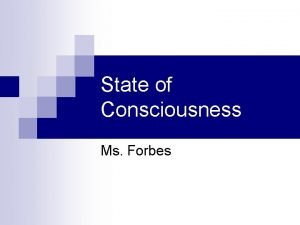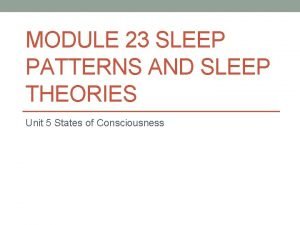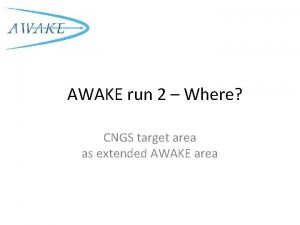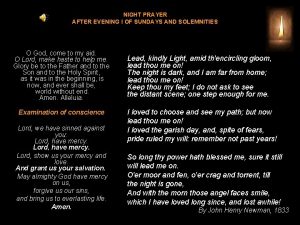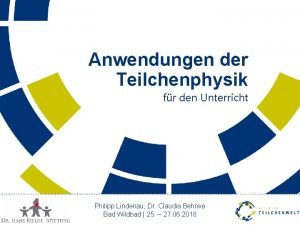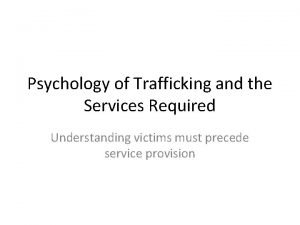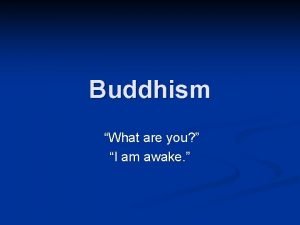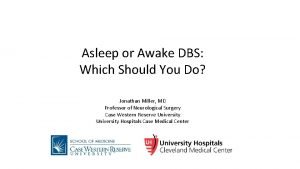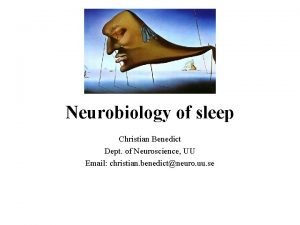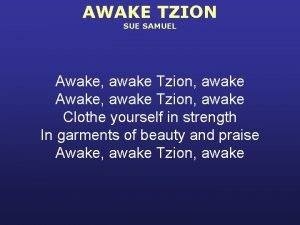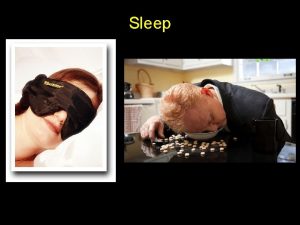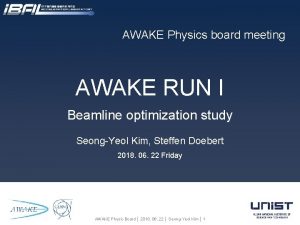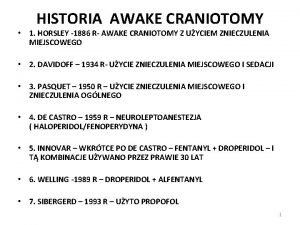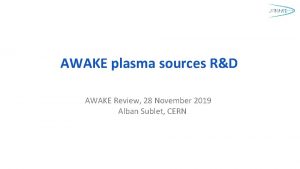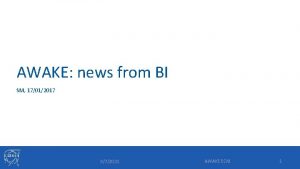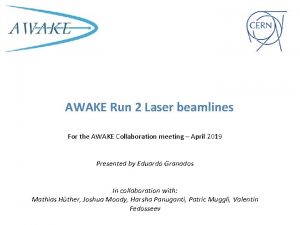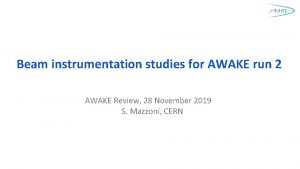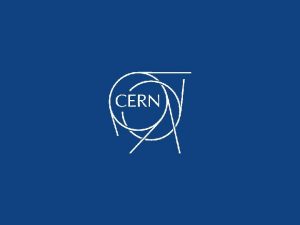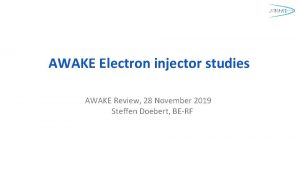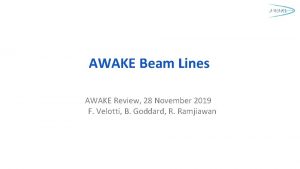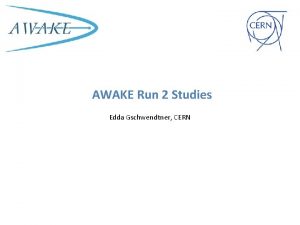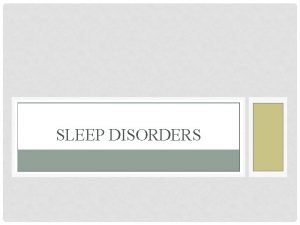Sleep stages Awake Stage 1 Stage 2 Slow





















- Slides: 21

Sleep stages § Awake § Stage 1 § Stage 2 Slow wave sleep § Stage 3 (NREM) § Stage 4 § Rapid eye movement sleep (REM)

EEG waves

EEG Electrode Placement

Classifying EEG brain waves § Frequency: the number of oscillations/waves per second, measured in Hertz (Hz) § reflects the firing rate of neurons § alpha, beta, theta, delta § Amplitude: the magnitude of brain waves, measured in millivolts (m. V), gives an indication of the wave’s “power”. § The number of neurons firing in synchrony & the distance between the neurons and the recording electrode

Delta Waves § Slowest frequency waves: 1 – 3 Hz § Associated tasks & behaviors: § deep, dreamless sleep, not moving, not attentive, sleeping

Theta Waves n Slow wave frequency: 4 – 8 Hz n Associated tasks & behaviors: State between wakefulness and sleep “Drowsy” n during sleep, meditation, internal focus, and prayer; subconsciousness. n

Alpha Waves Mid wave frequency: 8 - 13 Hz n Parietal and occipital lobes n Associated tasks & behaviors: n n Relaxing, watching television, light reading (e. g. , novel), eyes closed.

Beta Waves n High wave frequency: 12 - 35 Hz The “normal” dominant rhythm n mostly on temporal and frontal lobe n n Associated tasks & behaviors: n listening and thinking during analytical problem solving, judgment, decision making, processing information,

EEG Waveforms § Alpha § 8 -13 Hz § Parietal and occipital prominent § Relaxed wakeful § Beta § § § 13 -30 Hz Frontal prominent Intense mental activity § Delta § 0. 5 -4 Hz § Drowsiness/early SWS § Theta § 4 -7 Hz § Drowsiness/early SWS

Types and Stages of Sleep: NREM § Stage 1 – eyes are closed and relaxation begins; the EEG shows alpha waves; one can be easily aroused § Stage 2 – EEG pattern is irregular with sleep spindles (high-voltage wave bursts); arousal is more difficult

–Stage 3 – sleep deepens; ; theta and delta waves appear; vital signs decline; dreaming is common –Stage 4 – EEG pattern is dominated by delta waves; skeletal muscles are relaxed; arousal is difficult


REM Sleep § Presence of beta activity (desynchronized EEG pattern) § Physiological arousal threshold increases § Heart-rate quickens § Breathing more irregular and rapid § Brainwave activity resembles wakefulness § Genital arousal § § § Loss of muscle tone (paralysis) Vivid, emotional dreams May be involved in memory consolidation


REM Dreaming l“vivid l~3 and exciting” per night l. Longer, more detailed l. Fantasy world lnightmares NREM Dreaming l“just thinking” l. Shorter, less active l. Logical, realistic

Dream theories § Activation synthesis theory § Sensory experiences are fabricated by the cortex as a means of interpreting signals from the PGO activity. § Continual activation theory § Encoding of short term into long-term memories. § NREM sleep processes the conscious-related memory (declarative memory), § REM sleep processes the unconscious related memory (procedural memory).

Sleep Disorders § insomnia § sleep walking, talking, and eating § nightmares and night terrors § narcolepsy § sleep apnea

Sleep Disorders § Insomnia: persistent problems in falling asleep, staying asleep, or awakening too early § Sleep Apnea: repeated interruption of breathing during sleep § Narcolepsy: sudden and irresistible onsets of sleep during normal waking hours

Sleep disorders § Nightmares: anxiety-arousing dreams occurring near the end of sleep, during REM sleep § Night Terrors: abrupt awakenings from NREM sleep accompanied by intense physiological arousal and feelings of panic

Sleep Disorders § Somnambulism…sleepwalking § 40% of children will have an episode, peaking at between 11 -12 years of age; § Can be induced if arouse children during NREM; § associated with complete amnesia, § Occurs within 2 hours of falling asleep. . EEG. . reveals both waking and sleep signals. Considered benign.

Coma & Brain death § Definition: § Greek in origin – “deep sleep or trance” § It refers to an unconscious state characterised by a lack of both arousal and responsiveness
 Copyright
Copyright Module 23 sleep patterns and sleep theories
Module 23 sleep patterns and sleep theories Come sleep o sleep summary
Come sleep o sleep summary Module 23 sleep patterns and sleep theories
Module 23 sleep patterns and sleep theories Adults spend about ______% of their sleep in rem sleep.
Adults spend about ______% of their sleep in rem sleep. Module 23 sleep patterns and sleep theories
Module 23 sleep patterns and sleep theories Simple past of forgive
Simple past of forgive Food to stay awake
Food to stay awake Christ is risen from the grave come awake
Christ is risen from the grave come awake Awake
Awake We are awake
We are awake Night prayer
Night prayer Philipp maier awake
Philipp maier awake What is a trauma bond
What is a trauma bond Standing here in your presence in a grace so relentless
Standing here in your presence in a grace so relentless Animals poem class 10 figures of speech
Animals poem class 10 figures of speech Only that day dawns to which we are awake
Only that day dawns to which we are awake Awake the united states
Awake the united states Save us lord while we are awake
Save us lord while we are awake I am awake buddha
I am awake buddha Awake dbs
Awake dbs Sleep stage
Sleep stage



